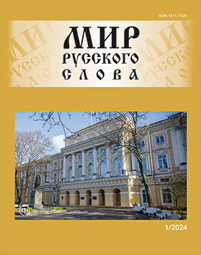Evaluative Constructions with the Word ‘Plokhoi’ (Bad) in Russian and Chinese Languages: The Experience of Comparative Analysis
DOI:
https://doi.org/10.21638/spbu30.2024.102Abstract
The article discusses the meaning and use of Russian constructions with the predicate plokhoi (bad) in comparison with their Chinese equivalents. The purpose of the research is to identify the correspondences and differences between evaluative syntactic structures with the word plokhoi (bad) in both languages. The main source of material is the texts in the parallel Russian Chinese corpus of The Russian National Corpus (the RNC). The sample consists of more than a hundred sentences collected by lexical search based on the markup of Russian texts and the markup of Chinese texts. Using the contrastive method, semantic analysis, contextual analysis and quantitative calculations, the author demonstrates interlanguage correspondences in expressing negative evaluation. Taking into account the grammatical structure of Russian statements like on plokhoi mal’chik (he is a bad boy), the author proposes three variants of search commands and observes the predominance of the full adjective plokhoi (bad) in the nominative case before the punctuation mark. Th ere are four evaluative constructions with the adjective 坏 [huai] in Chinese: 1) simple evaluative construction (N/Pron/V + 坏 [huai]); 2) main evaluation construction (N/ Pron + 是 [shi] COP/COPneg + (CLF) + 坏N); 3) construction with an evaluation of action (V + 得 [de] AUX + 坏 [huai]); 4) evaluation construction with a verb denoting belonging (Vpossession + 坏 N). The first two variants of the commands turn out to be more effective, while the last two types are considered as evaluative constructions inherent in the Chinese language. It is shown that in Russian evaluative constructions of our type are divided into simple evaluative construction with the predicate plokhoi (bad) and class inclusion construction, the latter one can be literally translated into Chinese using the copula 是 [shi] COP. A literal translation is oft en used when translating simple evaluative constructions in both languages, and a partially equivalent translation serves as a typical method for other varieties of evaluative constructions.
Keywords:
evaluation construction, comparative analysis, class inclusion construction, lexical search, classifi cation, Chinese language
Downloads
References
Downloads
Published
How to Cite
Issue
Section
License
Articles of "The World of Russian Word" are open access distributed under the terms of the License Agreement with Saint Petersburg State University, which permits to the authors unrestricted distribution and self-archiving free of charge.




